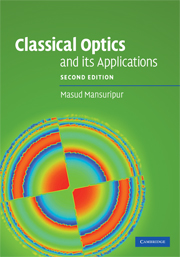Book contents
- Frontmatter
- Contents
- Preface to the second English edition
- Preface to the first edition
- Introduction
- 1 Abbe's sine condition
- 2 Fourier optics
- 3 Effect of polarization on diffraction in systems of high numerical aperture
- 4 Gaussian beam optics
- 5 Coherent and incoherent imaging
- 6 First-order temporal coherence in classical optics
- 7 The van Cittert–Zernike theorem
- 8 Partial polarization, Stokes parameters, and the Poincaré sphere
- 9 Second-order coherence and the Hanbury Brown–Twiss experiment
- 10 What in the world are surface plasmons?
- 11 Surface plasmon polaritons on metallic surfaces
- 12 The Faraday effect
- 13 The magneto-optical Kerr effect
- 14 The Sagnac interferometer
- 15 Fabry–Pérot etalons in polarized light
- 16 The Ewald–Oseen extinction theorem
- 17 Reciprocity in classical linear optics
- 18 Optical pulse compression
- 19 The uncertainty principle in classical optics
- 20 Omni-directional dielectric mirrors
- 21 Linear optical vortices
- 22 Geometric-optical rays, Poynting's vector, and the field momenta
- 23 Doppler shift, stellar aberration, and convection of light by moving media
- 24 Diffraction gratings
- 25 Diffractive optical elements
- 26 The Talbot effect
- 27 Some quirks of total internal reflection
- 28 Evanescent coupling
- 29 Internal and external conical refraction
- 30 Transmission of light through small elliptical apertures
- 31 The method of Fox and Li
- 32 The beam propagation method
- 33 Launching light into a fiber
- 34 The optics of semiconductor diode lasers
- 35 Michelson's stellar interferometer
- 36 Bracewell's interferometric telescope
- 37 Scanning optical microscopy
- 38 Zernike's method of phase contrast
- 39 Polarization microscopy
- 40 Nomarski's differential interference contrast microscope
- 41 The van Leeuwenhoek microscope
- 42 Projection photolithography
- 43 Interaction of light with subwavelength structures
- 44 The Ronchi test
- 45 The Shack–Hartmann wavefront sensor
- 46 Ellipsometry
- 47 Holography and holographic interferometry
- 48 Self-focusing in nonlinear optical media
- 49 Spatial optical solitons
- 50 Laser heating of multilayer stacks
- Index
- References
42 - Projection photolithography
Published online by Cambridge University Press: 31 January 2011
- Frontmatter
- Contents
- Preface to the second English edition
- Preface to the first edition
- Introduction
- 1 Abbe's sine condition
- 2 Fourier optics
- 3 Effect of polarization on diffraction in systems of high numerical aperture
- 4 Gaussian beam optics
- 5 Coherent and incoherent imaging
- 6 First-order temporal coherence in classical optics
- 7 The van Cittert–Zernike theorem
- 8 Partial polarization, Stokes parameters, and the Poincaré sphere
- 9 Second-order coherence and the Hanbury Brown–Twiss experiment
- 10 What in the world are surface plasmons?
- 11 Surface plasmon polaritons on metallic surfaces
- 12 The Faraday effect
- 13 The magneto-optical Kerr effect
- 14 The Sagnac interferometer
- 15 Fabry–Pérot etalons in polarized light
- 16 The Ewald–Oseen extinction theorem
- 17 Reciprocity in classical linear optics
- 18 Optical pulse compression
- 19 The uncertainty principle in classical optics
- 20 Omni-directional dielectric mirrors
- 21 Linear optical vortices
- 22 Geometric-optical rays, Poynting's vector, and the field momenta
- 23 Doppler shift, stellar aberration, and convection of light by moving media
- 24 Diffraction gratings
- 25 Diffractive optical elements
- 26 The Talbot effect
- 27 Some quirks of total internal reflection
- 28 Evanescent coupling
- 29 Internal and external conical refraction
- 30 Transmission of light through small elliptical apertures
- 31 The method of Fox and Li
- 32 The beam propagation method
- 33 Launching light into a fiber
- 34 The optics of semiconductor diode lasers
- 35 Michelson's stellar interferometer
- 36 Bracewell's interferometric telescope
- 37 Scanning optical microscopy
- 38 Zernike's method of phase contrast
- 39 Polarization microscopy
- 40 Nomarski's differential interference contrast microscope
- 41 The van Leeuwenhoek microscope
- 42 Projection photolithography
- 43 Interaction of light with subwavelength structures
- 44 The Ronchi test
- 45 The Shack–Hartmann wavefront sensor
- 46 Ellipsometry
- 47 Holography and holographic interferometry
- 48 Self-focusing in nonlinear optical media
- 49 Spatial optical solitons
- 50 Laser heating of multilayer stacks
- Index
- References
Summary
Photolithography is the technology of reproducing patterns using light. Developed originally for reproducing engravings and photographs and later used to make printing plates, photolithography was found ideal in the 1960s for mass-producing integrated circuits. Projection exposure tools, which are now used routinely in the semiconductor industry, have continually improved over the past several decades in order to satisfy the insatiable demand for reduced feature size, increased chip size, improved reliability and production yield, and lower overall cost. High-numerical-aperture lenses, short-wavelength light sources, and complex photoresist chemistry have been developed to achieve fabrication of fine patterns over fairly large areas. Research and development efforts in recent years have been directed at improving the resolution and depth of focus of the photolithographic process by using phase-shifting masks (PSMs) in place of the conventional binary intensity masks (BIMs). In this chapter we describe briefly the principles of projection photolithography and explore the range of possibilities opened up by the introduction of PSMs.
Basic principles
Figure 42.1 is a diagram of a typical projection system used in optical lithography. A quasi-monochromatic, spatially incoherent light source (wavelength λ) is used to illuminate the mask. Steps are usually taken to homogenize the source, thus ensuring a highly uniform intensity distribution at the plane of the mask. The condenser stop may be controlled to adjust the degree of coherence of the illuminating beam; this control of partial coherence is especially important when PSMs are used to improve the performance of optical lithography beyond what is achievable with the traditional BIMs.
- Type
- Chapter
- Information
- Classical Optics and its Applications , pp. 586 - 598Publisher: Cambridge University PressPrint publication year: 2009



